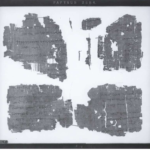| Artefact ID | 507 |
| TM ID | TM 61982 |
| Findspot (DEChriM ID) | 28 (al-Bahnasā) | Class | Textual |
| Material | Papyrus |
| Writing medium | Sheet/roll |
| Text content | Subliterary |
| Language | Greek, Coptic |
| Description | JEA 11 (1925): 241-246 + P.Rain.UnterrichtKopt. 257a A Greek-Coptic glossary on Hosea (2-8) and Amos (2). The glossary has been written on the verso of a repurposed papyrus sheet containing a Greek land register (CdE 91 (2016): 175-179; late 2nd c., Oxyrhynchus). The 4 fragments preserve 3 columns of the Christian Glossary. The scribe appears to have picked out difficult words and phrases from Hosea and Amos, to then give a keyword/phrase (as short excerpts or even abbreviations) in Greek together with a full Coptic translation. The Coptic translations are separated from the Greek head-words by a dicolon. The ed. pr. suggest that the text could have been part of a complete glossary to the Minor Prophets. Its use might have been liturgical; see VanHaelst 1976: 107. Fragment A: excerpts from Hosea 2.8-13 (Greek and Coptic) and 3.5 - 4.7 (Greek only; note the use of θεῷ instead of the established κυρίῳ in Hos. 4.1). Fragment B: excerpts from Hosea 4.8-11 (Coptic ends of lines) and 7.14 - 8.1 (Greek and Coptic). Fragment C: excerpts from Hosea 8.14 - 9.6 (Greek and Coptic). Fragment D: excerpt from Amos 2.8 - 15 (Coptic only). The hand on the recto is described as a right-sloping, elegant, cursive script. The cursive hand of the glossary has a Greek impression, see ed. pr. The Coptic text is of particular interest, as it is written in the Middle Egyptian (Mesokemic) dialect. Its early date (3/4th c.) makes the Greek/Coptic glossary contemporaneous with (or earlier than) the oldest existing Coptic biblical texts; see Clackson 2016: 338. |
| Selection criteria | Literary genre (Biblical), Subliterary genre (Liturgical), Coptic language |
| Date from | 250 |
| Date to | 350 |
| Dating criteria | Palaeography. The prosopography and palaeographical data of the original text on the recto (the land registry) gives a terminus post quem in the end of the 2nd c. for the more recent text of the verso. The glossary is dated to late 3rd (by the ed.pr.) and as late as the 4th c. by Arthur Hunt in a letter to the ed. pr. |
| Absolute/relative date | Relative date |
| Archaeological context | Acquired in 1924 by the British Museum from an unspecified dealer; see ed. pr. The prosopography of the land registry as well as the Mesokemic dialect of the Coptic of the glossary, indicate a provenance in Oxyrhynchus or the immediate area; see Benaissa 2016.
|
| Accession number | London, British Museum, EA 10825 Vo. |


 Json data
Json data




